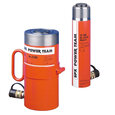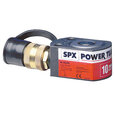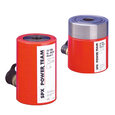Hydraulic Car Jack
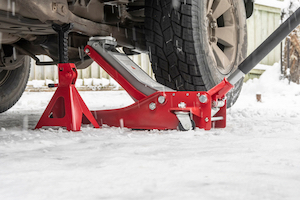
Figure 1: A floor jack lifts a car, and a jack stand provides support.
Hydraulic car jacks are used by individuals and businesses for a variety of automotive, agriculture, and construction needs to lift heavy loads. Choosing a hydraulic jack for an application involves considering several factors like its lift height, capacity, and clearance.
View our online selection of hydraulic jacks!
Hydraulic jacks for automobiles
Hydraulic jacks are high-capacity tools that lift heavy objects. A hydraulic jack can lift a car or a motorbike for mechanical and repair purposes. Using a hydraulic car jack, a person can easily lift an automobile 2 - 3 feet (61 - 91 cm) above the ground for repairs. Manufacturers use hydraulic floor and bottle jacks when assembling, inspecting, and working on a vehicle’s undercarriage. Mechanics, whether in a home garage or repair shop, also use hydraulic jacks. Check the following factors before using a hydraulic jack:
- There is a minimal working area at the bottom of the vehicle. Set up the vehicle on the flattest ground available. Ensure the car doesn’t move while lifting; secure the wheels by pulling on the parking brake.
- Never work under a car without the support of a jack stand. While the purpose of a hydraulic jack is to lift the vehicle, the jack stand supports the vehicle, thus ensuring the user’s safety.
- Use wheel chocks to prevent the vehicle from rolling. In the absence of wheel chocks, use cement blocks, bricks, or scrap wood instead.
- Choose an appropriate, sturdy jacking point under the vehicle. A jack point is a location that yields the best leverage. Check the vehicle’s manual for the jack points, as every vehicle is different. The most common jack points are near the front or back wheels.
How to lift a car using a bottle jack
A bottle jack is set up vertically underneath the vehicle. This design enables it to lift large weights at high elevations. Due to their small size, these jacks fit nicely on a garage shelf or in a car trunk, making them versatile and readily available.
Setting up the bottle jack
- Turn the air valve clockwise all the way using the jack handle. This closes the air valve.
- Place the handle in its proper position on the jack.
- Adjust the screw height on top of the jack to the required height to lift the car.
- Put the arm into the pump and lift the hydraulic ram. The ram pops up.
- Find the jacking point under the car.
- Move the jack handle until the car lifts.
- Place the jack stand under the car and raise its saddle to the highest point to fit under the car.
- Release the load from the jack by turning the air valve anticlockwise. Now the jack stand has the weight of the car. The user can work under the car at this point.
Removing the bottle jack
- Raise the car by a few inches using the jack to release the weight off the jack stand.
- Grab the jack stand saddle and lift it. Lift the handle simultaneously.
- Release the jack and remove it from the jacking spot under the vehicle.
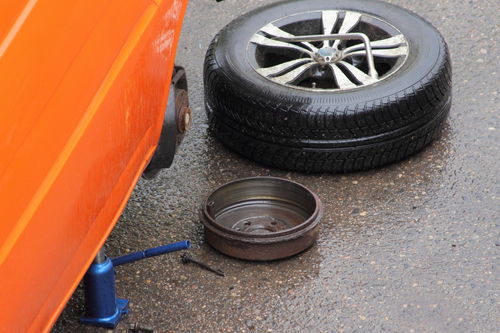
Figure 2: Using a hydraulic bottle jack to lift a car.
How to lift a car using floor jacks
Hydraulic floor jacks can fit under vehicles with low clearance to lift them for maintenance or repair work on the undercarriage. The following steps explain using a floor jack to lift a car.
- Place the floor jack under the car until the saddle is directly under the jack point. The saddle is the round metallic part of the floor jack that moves upward when the jack is pumped up. The saddle should settle into the vehicle frame with as much even contact as possible.
- Push the jack’s lever so the saddle lifts upward and touches the car frame. Push the lever downward to lift the car upward. Continue pumping until the saddle meets the vehicle frame and the vehicle is high enough to work on.
- Place the jack stand under the jack mounting point. Raise the jack stand until it touches the jack mounting point. Once in place, slowly open the release valve to lower the vehicle so it rests on the stand.
- Give the car a gentle push to ensure it is stable after it is jacked up. At this point, the user can begin working under the vehicle.
How to choose the right hydraulic car jack
The right hydraulic jack makes automotive repair work more accessible and safer. Consider the following factors while choosing a hydraulic jack for the car.
Weight capacity
A hydraulic jack’s weight capacity is the amount of weight the jack can lift, and the value is usually expressed in tons. Hydraulic jacks come in different weight capacities. There are a few factors to choosing a hydraulic jack with a particular weight capacity.
- Use a jack that corresponds to the most common weight ranges of the car that the user works on. For example, a 2-ton hydraulic jack is capable of lifting most automobiles, and a 3-ton jack can handle most trucks.
- A hydraulic jack supports only around sixty percent of the total vehicle weight; hence, a 2- ton jack can lift a 3-ton car.
Lifting range and capacity
A hydraulic jack should be capable of lifting the vehicle off the ground. Compare the strokes and maximum height for the bottle jack by looking at the number of steps on the piston. Measure the space available below the car and then compare the value against the height dimensions of the hydraulic jack. Usually, bottle jacks have a lifting range between 9 - 18 inches (228 - 457mm). A bottle jack tends to lift the loads higher as well. This is because the starting point of a bottle jack is higher, giving more room for the jack to lift.
Note: A vehicle with deflated tires will be lower to the ground.Take this into account while purchasing a jack for frequent use.
Working area
A floor jack’s low profile is beneficial. These devices sit close to the ground. Unlike bottle jacks, floor jacks can easily roll under vehicles that sit low. There are even specialized low-clearance jacks available for extremely low cars.
Material and quality
A superior-quality bottle jack is made of drop-forged alloy steel and high-quality iron. The body and the base of the bottle jack should be made from durable and sturdy steel so that the tool withstands the high pressure from lifting and holding the weight for a long period. This is especially important when using a bottle jack with a high lifting range. Also, pay attention to the quality of welds to ensure the best strength and performance. Hydraulic floor jacks are made out of steel or aluminum. The material does not significantly impact the lifting capacity of the hydraulic jack. However, aluminum floor jacks have less weight than steel jacks and hence are more portable.
Storage
Floor jacks are massive and bulky compared to bottle jacks. Bottle jacks are a better option when space is at a premium.
Stability
Floor jacks have a broad base, lifting the weight of the lifted vehicle over a wide area. Hence, the car has very less chance of falling off the jack while lifting. A bottle jack is small in size, and the vehicle's weight gets distributed over a small area. The jack can tip easily due to its narrow frame.
Cost
Bottle jacks are significantly cheaper than floor jacks.
Conclusion
- A bottle jack is the best choice for emergency uses. The tool can easily fit in the trunk of a vehicle. Also, the high clearances of a truck or farming equipment make perfect use of a bottle jack’s vertical alignment.
- Floor jacks have a high initial cost, but they can last a lifetime if maintained properly. These tools are popular while working in a garage environment.
Read our hydraulic jack overview article for more information on hydraulic jacks.
FAQs
What is the jack size needed to lift a car?
A jack should have a lifting capacity of around three-quarters of the vehicle's total weight.
What is the hydraulic jack size needed to lift a truck?
The hydraulic jack for lifting trucks usually has a capacity of 3 tons (6000 pounds) and a lifting height of 16 inches.
What does a hydraulic car jack do?
A hydraulic jack lifts part or the entirety of a car for repair or cleaning.




